Tea tree oil’s Terpinen-4-ol compound penetrates insect exoskeletons and disrupts nervous systems, making it highly effective against bed bugs, ants, mosquitoes, and cockroaches. You’ll create a powerful natural pesticide by diluting 20 drops in 200ml water for general use, or adjust ratios for specific pests. It’s non-toxic to families and pets when properly diluted, offering dual insecticidal and repellent properties. Understanding proper application techniques and safety measures will maximize your pest control success.
What Makes Tea Tree Oil Effective Against Household Pests
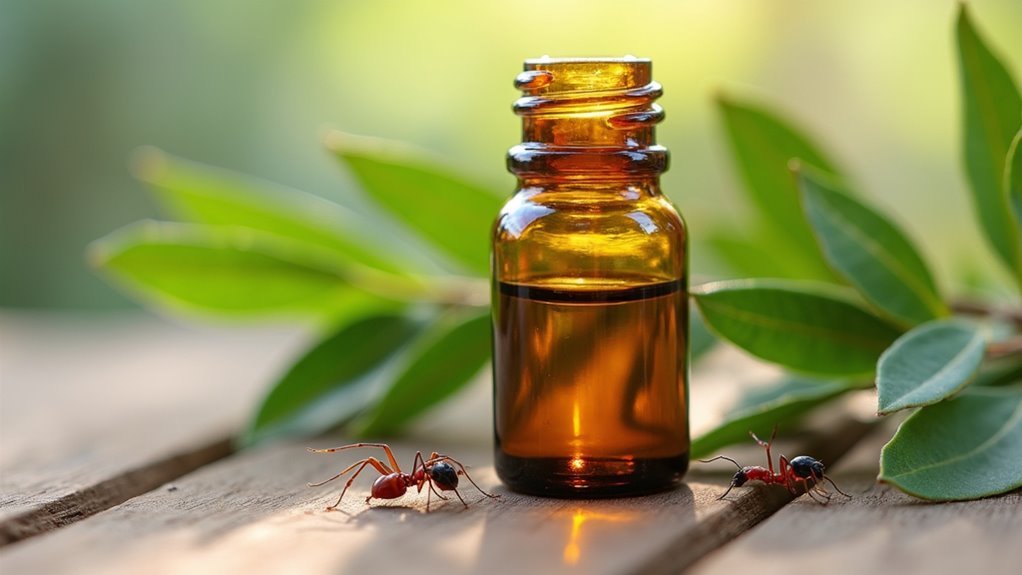
While conventional pesticides rely on harsh chemicals, tea tree oil harnesses the power of Terpinen-4-ol, a natural compound that delivers effective pest control through multiple mechanisms.
When you apply tea tree oil to affected areas, this active ingredient penetrates insects’ exoskeletons and disrupts their nervous systems, fundamentally suffocating bugs on contact.
Unlike synthetic alternatives, tea tree oils work as a natural insecticide through both toxic and repellent properties.
Tea tree oil functions as a dual-action natural insecticide, combining direct toxicity with powerful repellent effects against household pests.
The oil’s intense aroma creates an intolerable environment for mosquitoes, ants, and cockroaches, driving them away from treated surfaces.
Many pest control professionals recognize essential oils like tea tree as viable alternatives because they’re non-toxic to families and pets when properly diluted, yet remain lethal to unwanted insects.
How Tea Tree Oil Disrupts Pest Behavior and Biology
You’ll find that tea tree oil attacks pests through two primary biological mechanisms that make it remarkably effective.
The oil penetrates directly through insects’ exoskeletons, suffocating them by disrupting their respiratory systems on contact.
Additionally, its potent scent doesn’t just repel pests—it actually interferes with their nervous systems, preventing normal behavior patterns and colony communication.
Suffocation Through Exoskeleton Penetration
Tea tree oil’s insecticidal power lies in its ability to breach the protective barrier that keeps insects alive. When you apply this natural solution, it penetrates the exoskeleton of pests, disrupting their respiratory system and ultimately suffocating them.
The active compound Terpinen-4-ol drives these insecticidal properties, making tea tree oil remarkably effective against various household invaders.
Once the oil breaches their protective outer shell, pests can’t maintain proper respiration. You’ll notice that treated insects become sluggish before succumbing to suffocation.
This penetration mechanism works differently than synthetic pesticides, targeting the fundamental breathing process that insects rely on for survival. The oil’s molecular structure allows it to seep through even the smallest gaps in the exoskeleton, ensuring thorough coverage and reliable results against stubborn pest populations.
Scent-Based Nervous System Disruption
Beyond physical damage to their respiratory systems, tea tree oil launches a chemical assault on pest nervous systems through its powerful scent compounds.
The potent aroma creates chaos within insect neural pathways, causing disorientation and forcing pests to flee treated areas.
This natural repellent works by overwhelming insects’ sensory receptors, making your home an inhospitable environment.
The insecticidal effects manifest through:
- Nervous system disruption – Scent compounds interfere with normal brain function in ants, mosquitoes, and fleas
- Behavioral modification – Pests develop avoidance patterns around treated zones
- Sensory overload – Strong aromatics overwhelm insect receptors, causing confusion
- Territory abandonment – Affected areas become no-go zones for various pest species
You’ll notice reduced pest activity as tea tree oil’s scent creates an invisible barrier that insects simply can’t tolerate.
Target Pests: Which Insects Respond to Tea Tree Oil Treatment

When dealing with common household invaders, tea tree oil proves remarkably effective against a diverse range of pests that plague homeowners. This powerful essential oil targets bed bugs through direct contact, suffocating them on impact for immediate results.
You’ll find it equally effective against ant colonies, as the oil disrupts their nervous systems and prevents navigation back to nests. Mosquitoes, ticks, and fleas also respond strongly to tea tree oil’s potent scent, which naturally repels these biting insects.
Cockroaches experience similar nervous system disruption when exposed to diluted solutions. The oil’s dual-action approach combines immediate suffocation effects with long-term repellent properties, making it particularly valuable for addressing small infestations across multiple pest species in your home.
Proper Dilution and Application Methods for Maximum Results
You’ll need to mix tea tree oil at the right concentration to effectively repel pests without creating safety hazards in your home.
Proper preparation involves using a spray bottle with specific ratios that maintain the oil’s potency while ensuring safe household use.
Strategic application to targeted areas where pests hide and enter will maximize your treatment’s effectiveness.
Safe Concentration Ratios
Two critical factors determine tea tree oil’s effectiveness against home pests: proper dilution ratios and safe application methods.
This natural pesticide requires careful measurement to guarantee it’s both safe to use and potent enough to repel unwanted insects.
For effective application, you’ll need these key concentration ratios:
- General insect repellent: Mix 20 drops of 100% pure tea tree oil with 200 ml water in a spray bottle
- Ant-specific treatment: Combine 5-10 drops with 2 cups water for targeted pest control
- Pet-safe dilution: Use five parts water to one part tea tree oil, avoiding direct skin contact
- Maximum safety limit: Never exceed 50% concentration to prevent skin irritation
Always test your dilution on small areas first before widespread application to check for potential staining or adverse reactions.
Spray Bottle Preparation
Creating an effective tea tree oil spray requires the right equipment and precise measurements to achieve maximum pest-repelling results.
You’ll need a glass spray bottle to prevent chemical reactions that plastic containers might cause. Mix 20 drops of 100% pure tea tree oil with 200 ml of water for proper dilution. This ratio guarantees the solution remains effective against pests while staying safe for household use.
Before widespread application, test your spray on a small, inconspicuous area to check for staining or surface damage.
Focus your natural remedies on key areas where pests hide: mattress seams, furniture cracks, and entry points. Apply the tea tree oil solution daily for at least one week to target visible pests and maintain consistent protection throughout your home.
Target Application Areas
Strategic placement of your tea tree oil spray determines whether you’ll successfully eliminate pests or waste your efforts on ineffective applications.
Focus your water in a spray bottle solution on areas where common pests actually hide and travel.
When targeting bed bug infestations, concentrate on these critical zones:
- Mattress seams and box springs – These tight spaces harbor the majority of hiding bugs
- Furniture cracks and crevices – Inspect chairs, dressers, and nightstands thoroughly
- Carpet edges and baseboards – Common pathways for pest movement throughout rooms
- Entry points like window frames – Prevent new infestations from establishing
Using essential oils requires precision in each affected area.
Don’t spray randomly across entire rooms.
Instead, apply your tea tree oil solution directly where pests congregate for maximum contact and elimination effectiveness.
Safety Precautions When Using Tea Tree Oil Around Home and Family
While tea tree oil offers an effective natural solution for pest control, you must take proper safety precautions to protect your family and pets from potential harm.
Always perform a patch test before widespread use, as tea tree oil can cause skin irritation, dermatitis, and burning in sensitive individuals. Proper dilution is essential—never exceed 50% concentration, as higher levels can harm humans.
Always ventilate the area during application to prevent respiratory irritation, especially if anyone has asthma. Keep tea tree oil away from children and pets, as ingestion causes serious toxic effects including muscle coordination loss and confusion.
Most importantly, consult a veterinarian before using tea tree oil around animals, since pets can experience dangerous nervous system issues.
Combining Tea Tree Oil With Other Natural Pest Deterrents
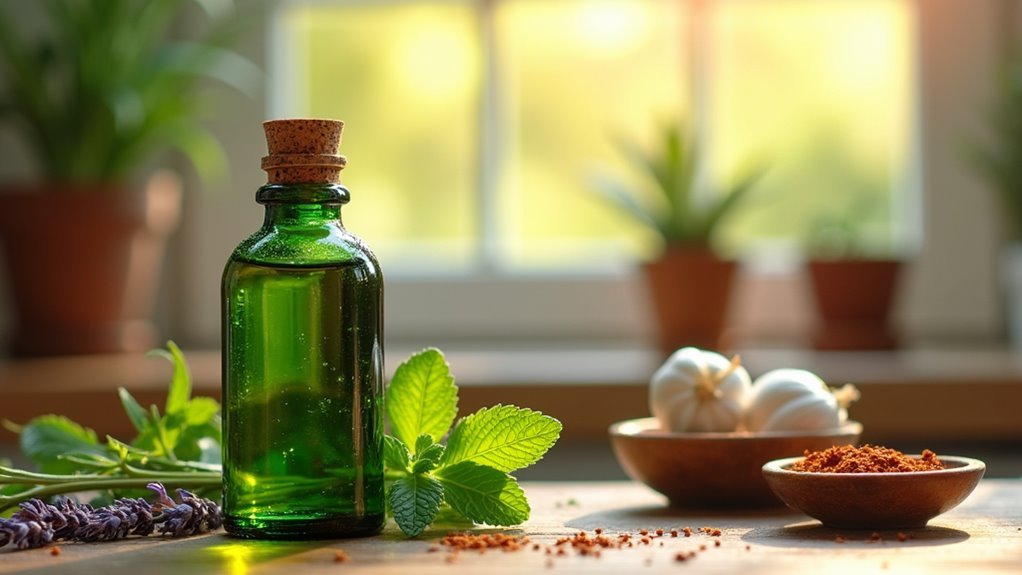
Although tea tree oil works well on its own, you’ll achieve better results by combining it with other natural oils that complement its pest-fighting properties.
While tea tree oil provides solid pest control alone, mixing it with complementary natural oils amplifies its bug-fighting power significantly.
These synergistic blends create powerful deterrents that target specific pest problems more effectively.
Here are the most effective combinations:
- Tea tree oil with lavender oil enhances scent appeal while boosting effectiveness against bed bugs through their combined repellent properties.
- Tea tree oil with peppermint oil creates a potent natural insecticide that repels mosquitoes and flying insects with strong aromatic compounds.
- Tea tree oil with eucalyptus oil bolsters protection against blood-sucking insects, making it ideal for outdoor summer activities.
- Tea tree oil with clove oil effectively targets cockroaches by disrupting their nervous systems with dual insecticidal properties.
You can also combine tea tree oil with diatomaceous earth for enhanced pest control through suffocation and dehydration.
Limitations and When Professional Pest Control May Be Necessary
Despite these powerful natural combinations, tea tree oil has significant limitations that you need to understand before relying on it as your primary pest control method. While it’s effective as a contact insecticide for bed bugs, it won’t eliminate hidden eggs or completely eradicate severe pest infestations.
| Pest Issue | Tea Tree Oil Effectiveness | Professional Help Needed |
|---|---|---|
| Minor infestations | Moderate success | Optional |
| Severe bed bugs | Limited impact | Essential |
| Hidden eggs | Ineffective | Required |
| Persistent problems | Temporary relief | Recommended |
| Extensive control | Supplementary role | Primary solution |
Delaying treatment worsens infestations, making timely professional intervention vital. Natural remedies work best when combined with thorough solutions including professional assessments and specialized treatments like heat therapy for ideal pest control results.
Alternative Essential Oils for Comprehensive Pest Management
Beyond tea tree oil, several other essential oils offer powerful pest-fighting properties that can enhance your natural home defense strategy.
You’ll find these alternatives create a thorough approach to pest management without relying on harmful chemicals.
- Peppermint oil acts as both a natural insecticide and repellent, effectively killing mosquitoes while soothing insect sting irritation.
- Eucalyptus oil disrupts cockroach nervous systems, serving as a potent natural insecticide without leaving toxic residues.
- Lavender, clove, cinnamon, and thyme oils provide broad-spectrum repellent properties against bed bugs, mosquitoes, and various home pests.
- Diatomaceous earth combined with essential oils targets bed bugs in cracks and crevices, dehydrating and eliminating them effectively.
Applying these oil mixtures strategically throughout your home creates multiple defense layers against unwanted pests.
Frequently Asked Questions
Does Tea Tree Oil Repel Bugs in the House?
You can use tea tree oil to repel bugs like bed bugs, ants, mosquitoes, and cockroaches in your house. It’s most effective when you spray diluted oil directly onto pests’ hiding spots.
Can I Spray Tea Tree Oil Around My House?
You can spray tea tree oil around your house by mixing 20 drops with 200ml water. Test surfaces first, then apply daily for effective pest control against ants, mosquitoes, and cockroaches.
How to Use Tea Tree Oil for Pest Control?
Mix 20 drops of pure tea tree oil with 200ml water in a spray bottle. Spray directly on pest hiding spots like mattress seams and furniture cracks. Reapply daily for a week to maintain effectiveness.
How Do You Dilute Tea Tree Oil for Insect Repellent?
You’ll dilute tea tree oil by mixing 20 drops of 100% pure oil with 200ml water in a spray bottle. Shake well before each use to distribute the oil evenly throughout the water mixture.
In Summary
You’ve discovered tea tree oil’s power against household pests through its natural compounds that disrupt insect behavior. You’ll find success targeting ants, spiders, and flies when you apply properly diluted solutions. Remember you’re working with a potent substance that requires safety precautions around pets and children. Don’t hesitate to combine it with other essential oils for enhanced effectiveness, but recognize when professional intervention becomes necessary for severe infestations.

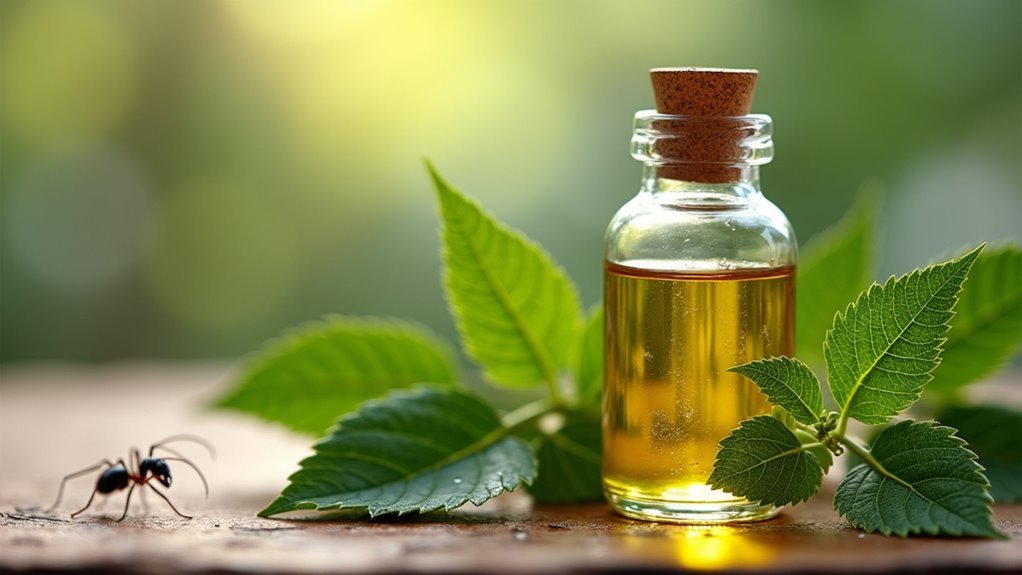
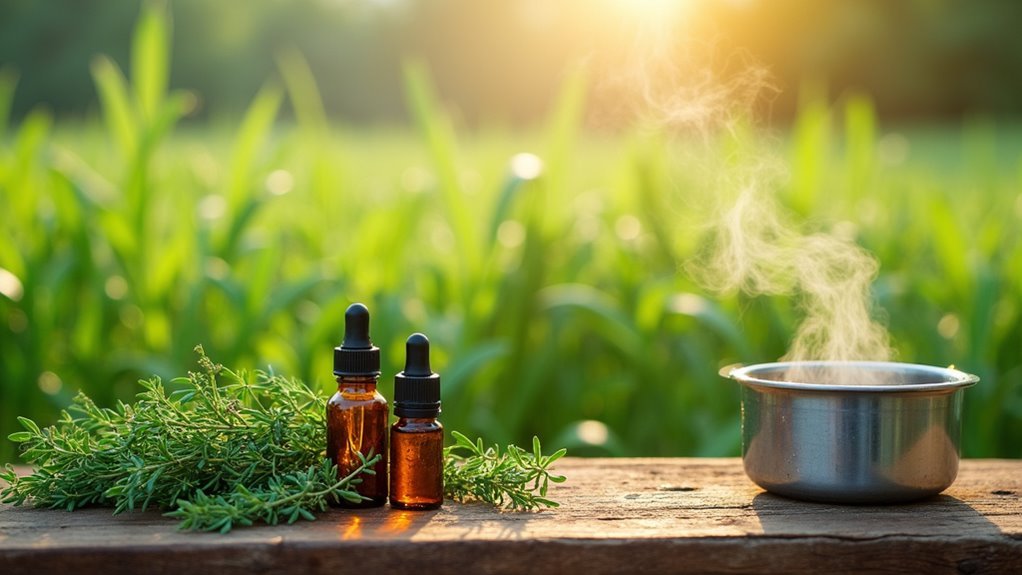
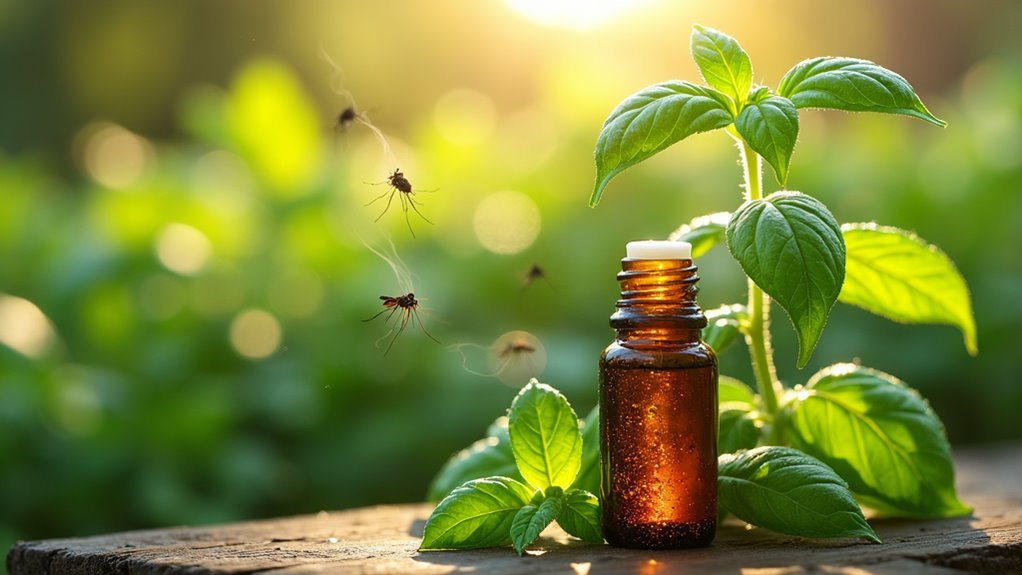
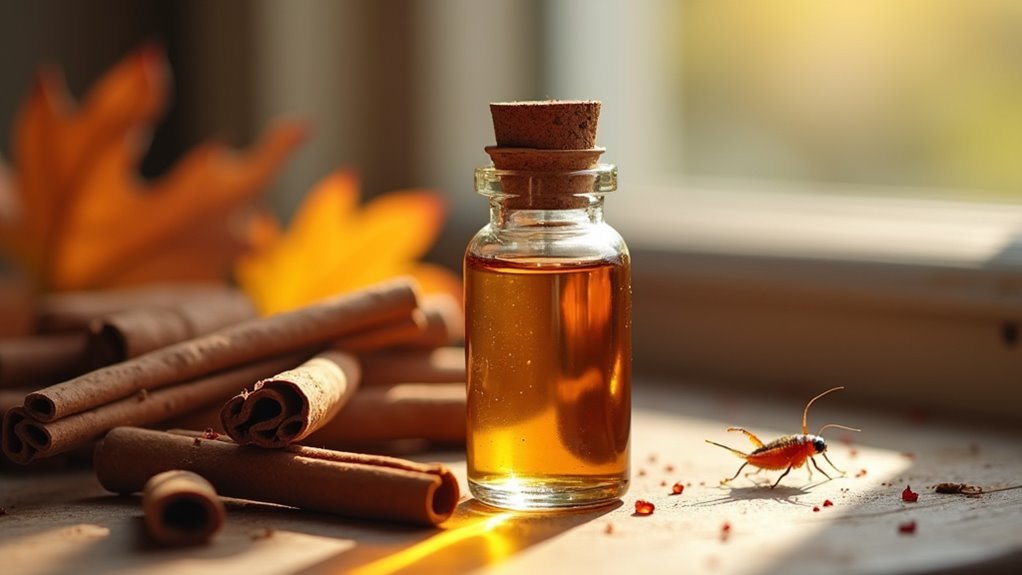
Leave a Reply